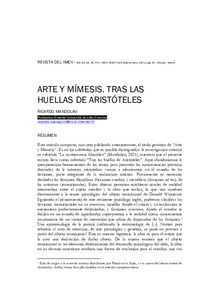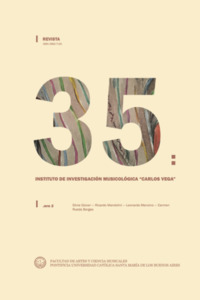Por favor, use este identificador para citar o enlazar este ítem:
https://repositorio.uca.edu.ar/handle/123456789/13750| Título: | Arte y mímesis: tras las huellas de Aristóteles Art and mimesis: in the footsteps of Aristotle. |
Autor: | Mandolini, Ricardo | Palabras clave: | ESTETICA MUSICAL; HEURISTICA MUSICAL; ANALISIS DEL DISCURSO | Fecha de publicación: | 2021 | Editorial: | Universidad Católica Argentina. Facultad de Artes y Ciencias Musicales. Instituto de Investigación Musicológica Carlos Vega | Cita: | Mandolini, R. Arte y mímesis: tras las huellas de Aristóteles [en línea]. Revista del Instituto de Investigación Musicológica “Carlos Vega”. 2021, 35 (2). Disponible en: https://repositorio.uca.edu.ar/handle/123456789/13750 | Resumen: | Resumen:
Este artículo comparte, con otro publicado anteriormente, el título genérico de “Arte
y Mímesis”. Es en los subtítulos que es posible distinguirlos: la investigación anterior
se subtitula “La controversia filosófica” (Mandolini, 2021), mientras que el presente
escrito lleva como subtítulo “Tras las huellas de Aristóteles”. Aquí abandonamos la
interpretación hermenéutica de los textos para presentar las consecuencias prácticas
derivadas de la mímesis aristotélica: vamos a adentrarnos en el mundo de las
ficciones, parte integrante de la realización artística. Previamente es necesario
deslindar las ficciones filosóficas (ficciones cuadro) y científicas (ficciones ad hoc), de
las artísticas (transicionales). Estas últimas permiten establecer niveles de realidad
intermedios entre el sujeto creador y la obra que realiza, lo que nos conduce
directamente a la teoría psicológica del objeto transicional de Donald Winnicott.
Siguiendo el pensamiento de este eminente psicólogo inglés, podemos clasificar las
ficciones transicionales en no inmersivas, aquéllas donde el artista y su realización se
encuentran perfectamente delimitados, y ficciones inmersivas, donde el creador se
desliza en un mundo de significados superpuestos a la realidad como consecuencia
involuntaria de un vector de inmersión que oficia de disparador de las ficciones.1
Una epistemología de la poiesis (utilizando la terminología de J.-J. Nattiez para
referirse al acto de creación), de raíz psicológica y genética, se pone en práctica a
partir del objeto transicional. Esta es nuestra hipótesis: la obra es para el artista que
la crea una derivación de dicho objeto. De la misma manera que el objeto
transicional es un elemento determinante del desarrollo psicológico del niño, la obra
en su devenir constituye también una forma de evolución para el creador; una vez terminado el proceso creativo que le da origen, el artista se verá libre para reconstruir
sus identificaciones y comenzar un nuevo trabajo. El artículo presenta seguidamente
la disciplina musicológica Heurística Musical, explicando sus antecedentes y sus
objetivos, así como su necesidad de existencia como complemento de la semiología
musical y de los análisis que de ella se derivan. Una de las proposiciones de la
Heurística Musical es la reconstrucción perceptiva de obras musicales
contemporáneas, consecuencia directa de la mímesis de Aristóteles. El presente
escrito culmina con una descripción metodológica de su aplicación, proponiendo
complementar el trabajo de reconstrucción realizado al análisis semiológico de la
obra de referencia. Abstract: This article shares, with another previously published, the generic title of “Art and Mimesis”. It is in the subtitles that it is possible to distinguish them: the previous research is subtitled “The Philosophical Controversy”, while the present paper is subtitled “In the Footsteps of Aristotle”. Here we abandon the hermeneutic interpretation of texts to present the practical consequences derived from Aristotelian mimesis: we are going to enter the world of fictions, an integral part of artistic achievement. First of all, it is necessary to distinguish between philosophical fictions (frame fictions) and scientific fictions (ad hoc fictions), from artistic fictions (transitional fictions). The latter allow us to establish intermediate levels of reality between the creative subject and the work he creates, which leads us directly to Donald Winnicott's psychological theory of the transitional object. Following the thinking of this eminent English psychologist, we can classify transitional fictions as non-immersive, where the artist and his work are perfectly delimited, and immersive fictions, where the creator slips into a world of meanings superimposed on reality as an involuntary consequence of an immersion vector that acts as a trigger for the fictions. An epistemology of the poiesis (to use J.-J. Nattiez’s terminology to characterize the creative act) with psychological and genetic roots, is put into practice on the basis of the transitional object. Our hypothesis is that the artistic work functionate as a derivation of it. In the same way that the transitional object is a determining element in the psychological development of the child, the work in its evolution is also a form of evolution for the creator; once the creative process that gave rise to it is over, the artist will be free to reconstruct his or her identifications and begin a new work. The paper presents afterwards the musicological discipline named Musical Heuristics, explaining its background and objectives, as well as its need to exist as a complement to musical semiology and the analyses derived from it. One of the propositions of Musical Heuristics is the perceptual reconstruction of contemporary musical works, a direct consequence of Aristotle's mimesis. This paper culminates with a methodological description of its application, proposing to complement the reconstruction work carried out with its semiological analysis. |
URI: | https://repositorio.uca.edu.ar/handle/123456789/13750 | ISSN: | 2683-7145 | Disciplina: | ARTE | Derechos: | Acceso abierto | Fuente: | Revista del Instituto de Investigación Musicológica “Carlos Vega” Año 35, Vol.35, No.2, 2021 |
| Aparece en las colecciones: | IIM - 2021 Año XXXV nro. 35-2 |
Ficheros en este ítem:
| Fichero | Descripción | Tamaño | Formato | |
|---|---|---|---|---|
| arte-mímesis-tras-huellas.pdf | 361,04 kB | Adobe PDF |  Visualizar/Abrir | |
| tapa_rev35-2.png | 118,7 kB | image/png |  Visualizar/Abrir |
Visualizaciones de página(s)
48
comprobado en 27-abr-2024
Descarga(s)
159
comprobado en 27-abr-2024
Google ScholarTM
Ver en Google Scholar
Este ítem está sujeto a una Licencia Creative Commons

